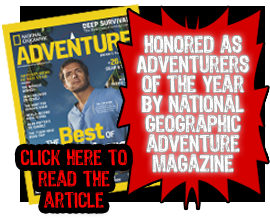 When picturing a national park, most of us probably think of rangers that help to protect the wildlife and answer visitors questions about the surrounding area and the flora and fauna that reside there. As you get farther and farther from the main tourist tracks in the world, the standard and definition of national parks changes dramatically.
When picturing a national park, most of us probably think of rangers that help to protect the wildlife and answer visitors questions about the surrounding area and the flora and fauna that reside there. As you get farther and farther from the main tourist tracks in the world, the standard and definition of national parks changes dramatically.
In Mauritania there is a park called “Banc d’Arguin National Park.” It is a World Heritage Site, and like many other World Heritage sites we have visited on our journey, it has a long way to go before one could call it protected. It does, however, offer something that no other national park has that we have been to…vastness.
The “entrance” to the park is a GPS coordinate listed on a small map provided by the park office in the small town 200kms away. This map has a list of GPS coordinates that we tested before we left for the park, of which over 30% of them were incorrect. We knew this going in, but figured that we navigated Mongolia with just binoculars and compasses so with the GPS…how could we go wrong?
The local population is only approximately 500 Imraguen tribesmen that live in seven villages within the park. We visited most of these villages and with so few people inhabiting over 12,000 square kilometers of space with no real infrastructure, it is safe to say you are on your own if something goes wrong. For three days we navigated the park, digging out of sand traps and motoring over sand dunes with a moderately accurate map and a couple of boards to help drive over soft sand.
I would not call this the most stunning or spectacular national park in the world, but it does offer a playground for a real deep in the dunes style Sahara experience. We left the park at the end more dehydrated and dirty than any of us have ever been in our lives, nearly out of gas, with sun and wind burns, but for three days we gave the largest desert in the world our best and came out triumphant.
At least you get the beach to yourself when there are no roads to it.

